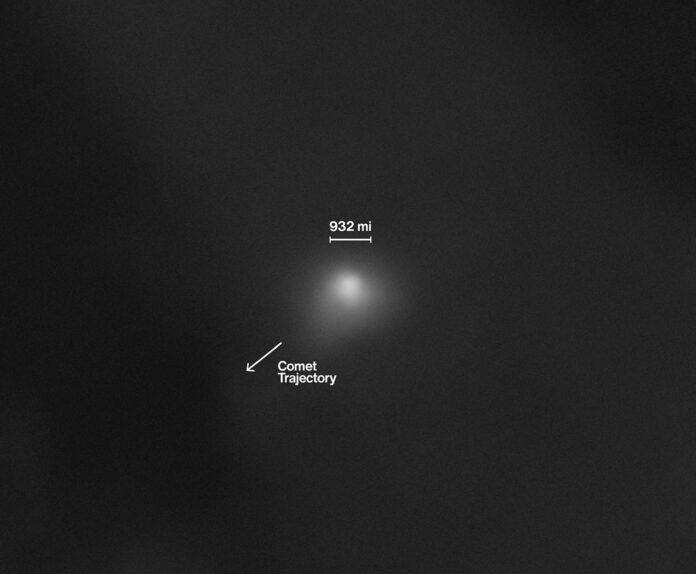
Key Findings
- A tiny interstellar visitor sharpens into view.
- The nucleus refuses to behave like ordinary comet dust.
- The new image raises questions NASA’s briefing has not yet answered.
By Samuel Lopez
USA Herald
NASA today released one of the clearest images yet of interstellar object 3I/ATLAS, captured by the High Resolution Imaging Science Experiment (HiRISE) aboard the Mars Reconnaissance Orbiter on October 2, 2025. The annotated frame shows the object’s trajectory and provides a scale reference of approximately 932 miles across the visible coma. Although NASA emphasizes that this HiRISE view primarily documents path and size, a closer forensic review reveals several structural features that may carry deeper scientific significance.
The enhanced version of the image, produced through careful sharpening, contrast balancing, and gradient isolation, reveals a dense, sharply illuminated nucleus surrounded by a faint but distinctly uneven envelope of ejected material.
The nucleus itself appears compact and more intensely reflective than typical dynamically new comets imaged at similar distances. Instead of fading gradually into the surrounding coma, the intensity drop-off around the core is steep, almost abrupt. This suggests a concentrated emission source rather than a diffuse dust ball.
Nothing in the enhanced data points toward fragmentation or disintegration. Instead, the nucleus maintains a cohesive geometry even after substantial sharpening.
One of the most intriguing features is the asymmetrical outflow extending downward along the comet’s annotated trajectory. The material is not evenly distributed. It appears heavier and more directional than standard sublimation. While not proof of non-gravitational thrusting, it does align with earlier independent reports describing unusual jet geometry and directional preference.
The downward plume hugs a narrow angle rather than blooming outward in the broad fan common to most comets. This narrowness may explain why ground-based telescopes have detected multiple jet orientations that do not appear in NASA’s earlier, lower-resolution frames.
The darkness surrounding the core is also noteworthy. Even after enhancement, the field displays surprisingly little particulate scatter. With most comets at this stage of approach, bright dust grains typically radiate outward in visible arcs. Here, the surrounding darkness remains uniform and unbroken, which could indicate either exceptionally low dust production or emission dominated by a different mechanism entirely.
NASA’s own briefing suggests that hydrogen was detected using MAVEN’s spectrograph, confirming water breakdown. Yet the visual structure of the coma does not resemble classical water-driven shedding. It appears compact, directional, and unusually stable.
The steep intensity boundary around the nucleus may imply rapid outgassing from a small number of high-density vents, rather than the distributed sublimation pattern expected from natural comets. However, it is equally possible that the geometry is influenced by viewing angle and the object’s orientation relative to the Sun and Mars Reconnaissance Orbiter.
HiRISE is not designed for deep-space comet imaging, but the detail captured here is strong enough to raise legitimate scientific questions about the anisotropy of 3I/ATLAS’s outflow.
NASA’s official description characterizes the image in purely neutral terms: an annotated trajectory and scale bar documenting the interstellar comet’s passage. What the agency has not yet addressed is the stark concentration of the nucleus, the asymmetric tail density, and the lack of surrounding dust scatter.
These features do not prove any extraordinary hypothesis, yet they sit uncomfortably alongside earlier assumptions that 3I/ATLAS is behaving like an ordinary natural comet. Based on this image alone, its behavior appears more structured and less diffuse than classical models predict.
As higher-resolution imagery becomes available and scientists compare NASA’s data with ground-based spectral analyses, more clarity will emerge.
For now, this HiRISE capture contributes meaningfully to the growing body of evidence that 3I/ATLAS is an object whose morphology defies easy categorization, and whose structure may reveal complex dynamics not yet explained by standard coma physics.
OFFICIAL STATEMENT (NASA)
“An annotated version of the image of 3I/ATLAS captured by NASA’s Mars Reconnaissance Orbiter shows the trajectory of the interstellar comet along with a scale bar. The image was captured by the spacecraft’s High Resolution Imaging Science Experiment (HiRISE) camera on Oct. 2, 2025.”— NASA/JPL-Caltech/University of Arizona


